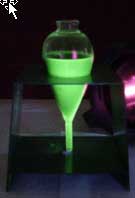Suspension Contamination
 The suspension solution should also be examined for evidence of contamination. Contamination primarily comes from inspected components. Oils, greases, sand, and dirt will be introduced to the system through components. If the area is unusually dusty, the system will pickup dust or other contaminates from the environment.
The suspension solution should also be examined for evidence of contamination. Contamination primarily comes from inspected components. Oils, greases, sand, and dirt will be introduced to the system through components. If the area is unusually dusty, the system will pickup dust or other contaminates from the environment.
This examination is performed on the carrier and particles collected for concentration testing. The graduated portion of the tube is viewed under ultraviolet and white light when fluorescent particles are being used, and under white light when visible particles are being used. The magnetic particles should be examined for foreign particles, such as dirt, paint chips and other solids. Differences in color, layering or banding within the settled particles would indicate contamination. Some contamination is to be expected but if the foreign matter exceeds 30 percent of the settled solids, the solution should be replaced.
The liquid carrier portion of the solution should also be inspected for contamination. Oil in a water bath and water in a solvent bath are the primary concerns. If the solution fluoresces brightly when fluorescent particles are being used, this can be an indication that dye is being dislodged from the particles by the mixing pump. While not technically contamination, this condition should be further evaluated by allowing the collected sample bath to set for 10 to 12 hours and viewed under ultraviolet light. If a band that fluoresces brighter than the bulk of particles is evident on top of the settled solids, the bath contains excessive unattached fluorescent pigments and should be discarded.
Water Break Test
A daily water break check is required to evaluate the surface wetting performance of water-based carriers. The water break check simply involves flooding a clean surface similar to those being inspected and observing the surface film. If a continuous film forms over the entire surface, sufficient wetting agent is present. If the film of suspension breaks (water break) exposing the surface of the component, insufficient wetting agent is present and the solution should be adjusted or replaced.